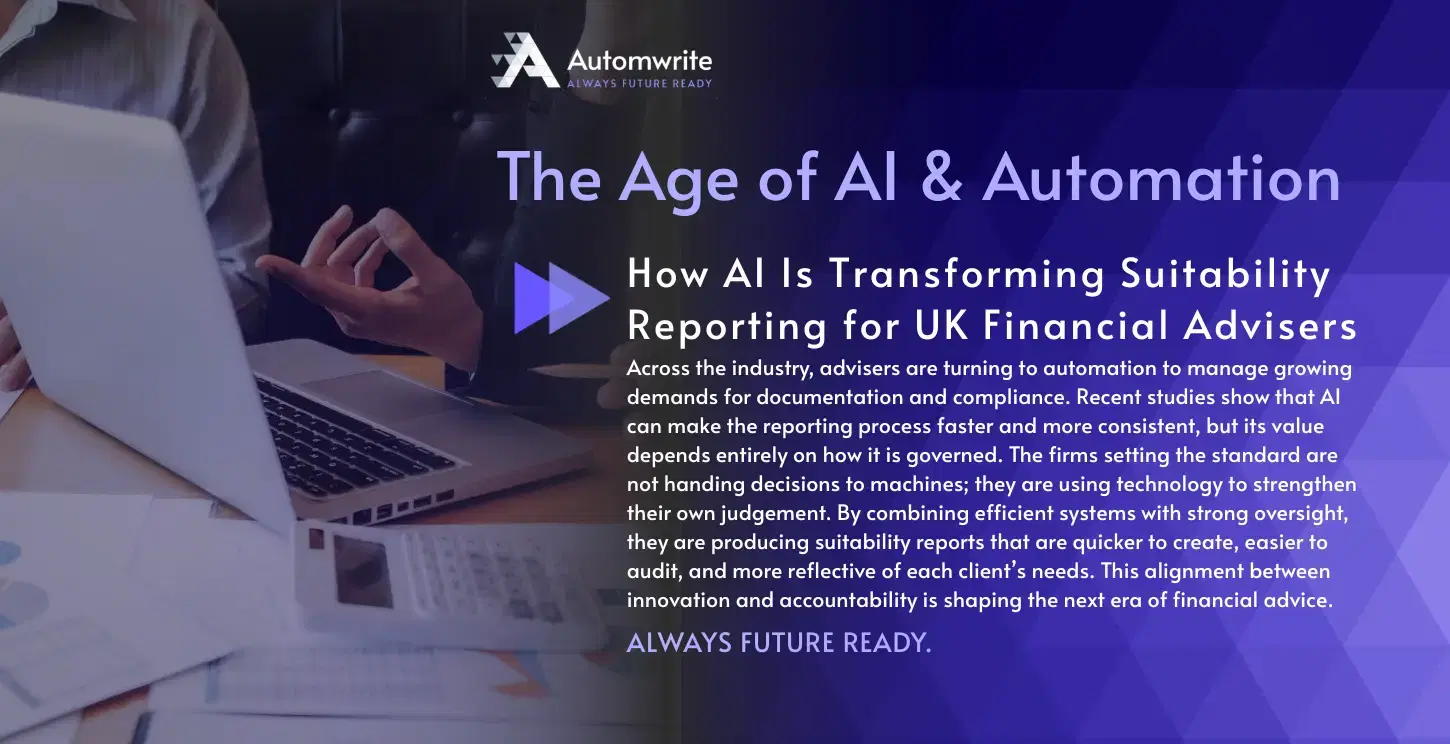
The rise of “AI suitability report generation” is often framed as progress towards faster document production, fewer errors, and a consistent audit trail. As AI systems get more robust, and specialty software emerges, it now begs the question… can AI generated suitability reports meet the ethical and procedural standards that have always defined professional advice?
When Regulation Meets Reinvention
A recent Cambridge study by Buczynski et al. (2025) describes financial services entering a “second generation” of AI oversight—where familiar frameworks like MiFID II, GDPR, and SM&CR are being repurposed for technologies such as robo-advice and generative AI. The authors anticipate that regulators will soon demand clear lines of managerial accountability for automated outputs: who designs the algorithm, who supervises it, and who remains responsible when it errs.
MiFID II already expects advisers to justify recommendations against a client’s goals, risk tolerance, and financial capacity. The Central Bank of Ireland’s 2021 review found that many firms still fall short—producing generic suitability statements, relying on client self-assessments, and overlooking vulnerable customers. Automation, if applied carelessly, risks amplifying those weaknesses rather than resolving them.
The Double Edge of Generative AI
The Cambridge team devotes a section to generative AI, acknowledging its potential to support multilingual client communication, compliance documentation, and internal knowledge management. But they caution that these systems also “hallucinate” and deliver quite persuasive but false statements.
In a regulated context, that risk is existential. A single fabricated sentence in a suitability report—an invented rationale or misstated figure—can undermine both client trust and regulatory standing. Their advice is pragmatic: keep a human firmly “in the loop,” verify every factual claim, and build an auditable record of edits and approvals.
Data Quality as the New Conduct Risk
Article 10 of the EU AI Act requires that training and testing data be “relevant, representative and free of errors.” Buczynski et al. argue that this principle must extend beyond model training to everyday business data—the client information feeding each automated recommendation.
The Irish review exposes why that matters. Too many firms rely on clients’ self-declared capacity for loss and neglect to validate or update their records. In an AI-driven process, flawed inputs can propagate instantly across thousands of reports. Periodic data verification, consistency checks, and manual oversight remain core parts of suitability, regardless of the software used.
Standardisation Versus Substance
Both sources warn against letting technology flatten nuance. The Central Bank notes that templated suitability reports “significantly reduce the ability of clients to make informed decisions,” while the Cambridge paper raises parallel concerns about over-reliance on a handful of dominant foundation models leading to uniform thinking across firms.
The real opportunity lies in personalisation at scale—using automation to compile facts efficiently so advisers can spend time crafting explanations that feel human, not formulaic. Consistent, but careful not to erase individuality.
Practical Steps for Responsible AI Suitability Reporting Adoption
Advisers considering AI-assisted suitability report generation can draw four lessons from these studies:
- Assign clear accountability. Every automated output must map to a named senior manager under SM&CR or equivalent frameworks.
- Validate data rigorously. Do not rely solely on self-reported inputs; test assumptions about income, capacity for loss, and experience.
- Audit the model. Keep change logs and sample reviews to monitor bias, hallucination, and factual accuracy.
- Prioritise interpretability. Ensure generated text explains why a product suits the client in plain, accessible language.
These actions align AI deployment with the very principles MiFID II enforces: transparency, proportionality, and fair treatment.
Redefining Professional Judgement
An adviser’s role it the equation is only amplified by automation. Their importance heightened. Algorithms can sort data, but only human discernment can judge when that data misleads or omits context. The next phase of regulation will test not how advanced a firm’s systems are, but how consciously they are used.
AI suitability report generation should never mean delegating suitability itself. At best, it becomes an instrument of discipline—an aid to clearer reasoning and cleaner records, not a substitute for either.
Firms ready to modernise their advice process can do so without losing the personal quality that defines good service. Automwrite helps advisers draft FCA-compliant suitability reports in seconds, grounded in client data, your advice, and your professional oversight. It’s an AI and Automation tool built for regulated advice. Automwrite is practical, auditable, and designed for real-world use.

Frequently Asked Questions on AI Suitability Reporting
1. Is AI-generated suitability reporting compliant with FCA and MiFID II rules?
AI can support report creation, but compliance always depends on how it’s used. Every recommendation must still reflect verified client data and adviser judgement. Automwrite was designed for UK advisers to produce FCA-aligned suitability reports that maintain full human oversight.
2. How can AI improve the suitability report process for advisers?
When properly governed, AI helps advisers draft reports faster, pull accurate client information, and maintain consistency across templates. The result is more time for client conversations and less time on formatting and manual data entry.
3. What should firms have in place before adopting AI suitability reporting?
Before implementation, firms should ensure they have strong data governance, clear accountability for AI outputs, and a human review process for every report. These steps help maintain trust and meet regulatory expectations for fair, transparent advice.